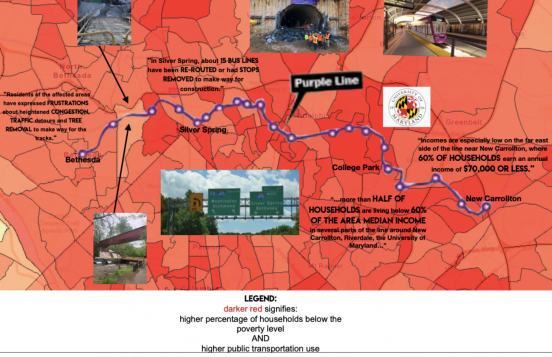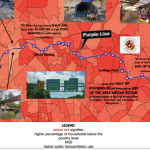The Purple Line is a light rail metro line currently being constructed in the Washington, DC/Maryland metropolitan area. The goal of the project is to connect the Maryland counties of Montgomery and Prince George’s with the larger DC Metrorail system, as well as allowing for increased connections to local train and bus services. It will span east to and from the city of Bethesda in Montgomery County, (one of the most affluent areas in the nation) and New Carrollton in Prince George’s County (a more racially and socioeconomically diverse county). The rail will also serve College Park, the home of the University of Maryland’s main campus.
As the rail line has not been completed (and construction has been delayed for various reasons), predictions on how the project will actually impact communities and landscapes are all conjecture. Proponents argue that the line will decrease traffic on the major highways that surround the area, and increase job mobility with a novel connection to the Washington, DC metro system. Although this may be true in the long run, residents of the Silver Spring area have expressed discontent at some of their bus lines being shut down due to construction, and other residents have been equally frustrated with increased traffic congestion, pollution, and noise caused by construction.
Many concerns also lie in the realm of housing equity and zoning. Residents of lower socioeconomic towns are wary of being priced out of their homes once the stations are incorporated into their communities. One group in particular, the Purple Line Corridor Coalition has created a comprehensive set of recommendations for the transport authority to ensure protections on tenants and the affordable housing in the area. The developers have agreed to take these guidelines into consideration.
With all of this in mind, I argue that the Maryland transportation authorities are attempting to incorporate social and environmental sustainability with the information and feedback they have. In this way, they are promoting just sustainabilities. However, the stakeholders have the opportunity to continue advocating for their wellbeing and influence the development of the project. It is important that both parties continue this level of open communication to ensure that the Purple Line remains environmentally and socially just. Of equal importance is the differing levels of privilege and power that are afforded to certain voices over others.




bromleyd
May 1, 2020 — 5:38 pm
I live in Maryland, and I hadn’t even heard of this project so I am really glad to know that ultimately the people in surrounding communities are being given the consideration they deserve. There are many areas around Maryland and Baltimore that have become progressively more gentrified and all it has done is compound existing racial issues, so it is very important that all stakeholders are taken into account and have the information they need through this process. Really nice visual too!
palaciom
May 1, 2020 — 5:50 pm
I really enjoyed the visusal as it shows exactly through what communities the purple line is passing through. A question I have though is how long has it taken for them to construct the line and is there a date for when it is supposed to finish ?
levinana
May 1, 2020 — 6:06 pm
Thank you! The actual planning and physical construction of the metro line began around 2016, but the initial proposal and research process goes back as far as 2002.
The developers plan to open the Prince George’s County section (right side of the map) in late 2022, and the other section in 2023. However, the current pandemic may affect funding and/or construction schedules, so I wouldn’t be surprised if it takes even longer.
burkea
May 1, 2020 — 5:54 pm
Hi there! I love this project-
I was wondering if you have any further suggestions as to how the Maryland Transportation Authority can ensure that the purple line, once established, is accessible to everyone. Perhaps residents could qualify for reduced fares?
Although it seems like they are taking residents concerns into consideration, it also seems like the rail may be built no matter what!
levinana
May 1, 2020 — 6:36 pm
Hi Anna! I really like your suggestion about need-based reduced fares. So far, fares and other details about the operations of the line have not been decided upon (or at least released to the public yet) since the project still has at least 2 more years before construction is finished.
I think committing to work with municipalities to stabilize housing prices in the area would be a crucial way that the MTA could demonstrate equity across communities. Keeping the housing prices from fluctuating could also decrease gentrification, which is a big issue affecting new development areas.
pikturne
May 1, 2020 — 6:01 pm
Ariel,
Your project brings up some really interesting points! I’m all for public transportation, but I never thought about the social and environmental implications that the infrastructure has. I wonder, however, how does one ensure this is just? Considering that it runs through so many neighborhoods, there are so many voices to be heard
levinana
May 1, 2020 — 7:01 pm
Hi Emily,
I identified the project as just because there was a concerted effort to communicate the effects of construction with members of the affected population. The Maryland Transportation Authority (MTA) held meetings and focus groups for residents of minority and low-income neighborhoods and have distributed important documents in both English and Spanish.
It will be interesting to see the effects of the metro line once it is completed and in use, and hear feedback from the residents most affected by construction.
Claudia
May 1, 2020 — 6:03 pm
I was glad to read that the Maryland Transportation authorities have agreed to take the guidelines into consideration made by the coalition. Has the transport authority made any changes since communicating with the coalition? I wonder if there is any true weight to their agreement to communicate.
levinana
May 1, 2020 — 7:21 pm
Hi Claudia,
When the coalition’s framework was released to the public, it received positive feedback and support from both the Montgomery and Prince George’s County Executives, who helped advise the plan. Hopefully, the endorsement from government officials will put pressure on the developers to act on their words. When the line is finished, the extent to which developers followed through on their word will be more clear, but in the meantime residents have a unique opportunity to fight for increased transparency and equity.
bascolot
May 1, 2020 — 6:06 pm
I loved your project, I was looking forward to seeing your blog presentation. I live in Maryland as well and I have seen those constructions but I was not aware of the plans to build the purple line. I have ridden my bicycle right next to those constructions many times. What is so interesting to me and what I think is great about your project, is that I would have never thought about the impact that would have on housing and different neighbors. It is great that you were able to focus on this and even get information on the current situation.
Great great job!
Best!
messimeg
May 1, 2020 — 6:09 pm
I had never heard of this project before, but it’s cool to see an example of just sustainabilities here that really showcases how projects like this can help the economy and the people while being sustainable. Your map is interesting and helpful to understand the geography and what is being affected by this project.
A.R.
May 1, 2020 — 6:10 pm
I love the complexity of your project and how you outlined both the just sustainabilities occurring while highlighting inequitable access to voice and power through voice. You mention that the Purple Line Corridor Coalition has created recommendations to minimize gentrification – how successful has this actually been in practice? Have developers actually shown action that proves they are in agreeance? Also, if this coalition community based or governmental?
levinana
May 1, 2020 — 7:38 pm
Thank you! The coalition is a collaboration between non-profit organizations, county government officials, and businesses in the area–sort of a combination of stakeholders from various parts of the involved communities.
So far, the developers have not taken explicit action beyond agreeing to implement the plan’s suggestions as feasibly as possible, but other organizations have stepped in to prevent gentrification, like the bank JPMorgan which has devoted $5 million in grants towards affordable home construction, small business loans, and bilingual resources impacted by the Purple Line.
I would hope that the actions taken by governments and large businesses would spur the Purple Line Transit Partners (who are building and maintaining the line) to act beyond simple promises.
galbanv
May 1, 2020 — 6:10 pm
It’s very refreshing to see a just sustainability in action! The involvement of the stakeholders sounds like it is key to the just success of this project. I loved your visual, too. It’s simple and easy to read, but I still feel like I get a lot of information from it.
Maggie Douglas
May 1, 2020 — 6:19 pm
The detail on your map I found most interesting was the impact of the rail project on the bus lines. Is it your sense that residents in the affected areas will use the purple line once it opens? Or does the bus better serve their needs? Overall thoughts on the justice implications of bus vs. rail development?
Nat
May 1, 2020 — 6:26 pm
This was a really fascinating topic to study! It was interesting to hear how the community has responded in different ways to the changes.
brownemm
May 1, 2020 — 6:40 pm
This is such an interesting project. Really interesting to see how the implementation of a project that will ultimately bring down pollution affects people and communities in so many different ways and how planning that doesn’t take these communities into account can have disastrous consequences. This is especially interesting to me because I hope metropolitan areas all over the U.S. continue to expand their public transportation infrastructure and while lack of good public transportation can be a social justice issue, projects like this can also deepen inequality. I’m glad the transit authority is communicating with the community and hope other cities and regions learn from this.
Sooik
May 2, 2020 — 5:30 am
I like it that you put the projected Purple Line on the EJ map highlighting households below the poverty level. It is really easy to comprehend the communities around the Purple Line and how it might affect them. While this is undoubtedly an important project, it is also interesting to see how some parties raised their concerns about noise and traffic congestion. As you said, I definitely believe that the Purple Line project is important to increase the local connection and thus promoting just sustainability as long as it ensures no one involved is left behind.